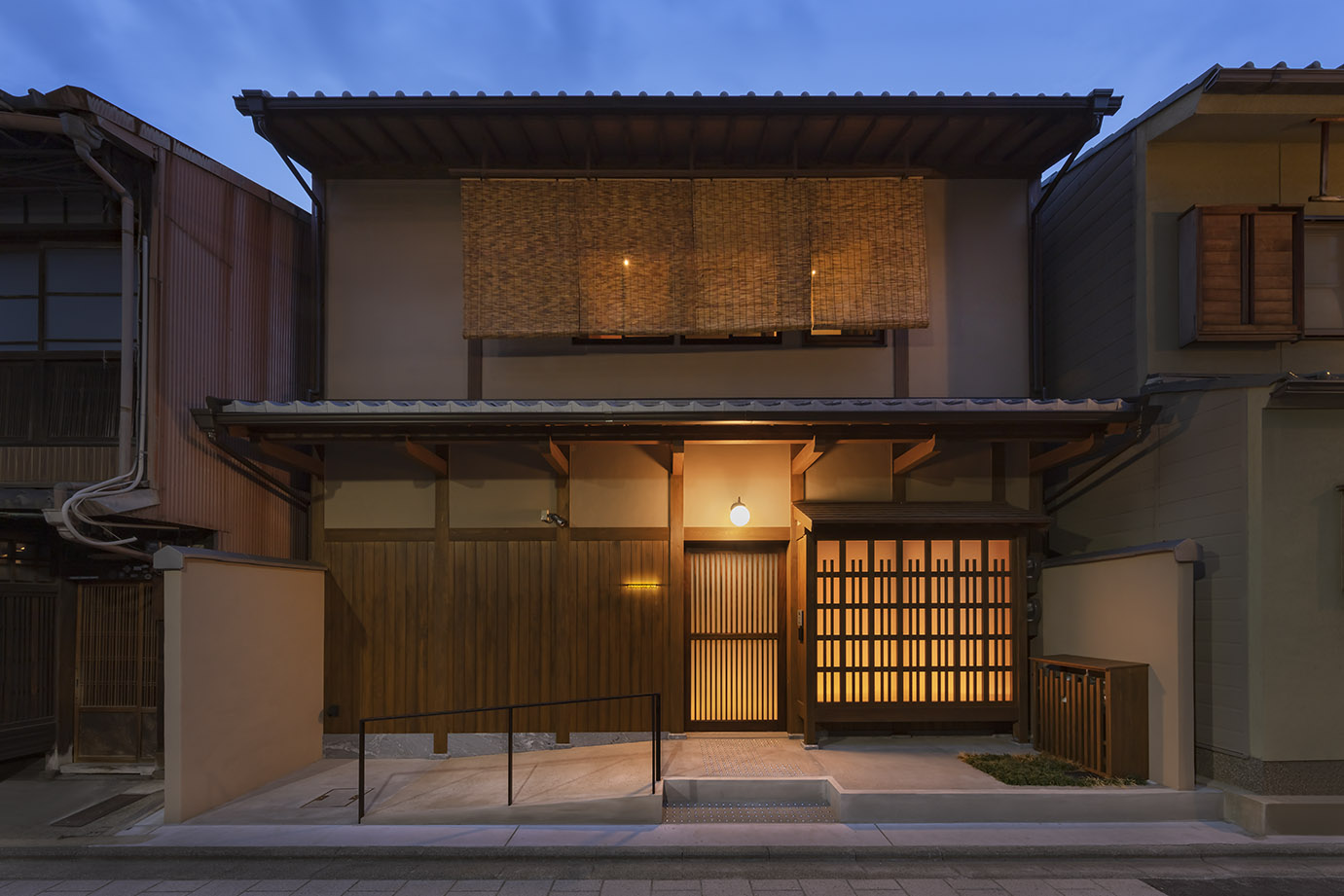

鈴 京都宮川筋 hitotose -龝-
2023
京都の伝統的な5つの花街のひとつ「宮川町」に1棟貸しの宿泊ホテルです。花街とは江戸時代から続く歌舞・音曲を専門とする芸奴・舞妓がその艶やかな芸を披露するお茶屋さんが立ち並ぶエリアです。同じ京都といえども、昔ながらの「陰翳礼讃」を感じるこの通りは「宮川筋」とも言われ、現代の今もなお、その風情を漂わせています。そんな街並みを歩きながらゲストがたどり着くこの宿は、あくまでもこの風情を壊さず近隣環境に溶け込むことにより地域全体のまとまりを重視しました。また、ひとたび中に入ると千利休も好んで取り入れたと言われるなぐり加工を施した高さ2700mmの建具が出迎えその先には、リビング・ダイニング、そしてバルコニーの露天風呂へとシームレスに続く開放的な空間が広がります。
私はデザインの答えには、その場で過ごすゲストへの心配りが重要で、実は図面や写真には見えてこないことが大事なのではと考えます。そこで「時間をデザインする」ということを心がけて空間構築してきました。町家の滞在はノスタルジックでいいものですが、夏の酷暑も床がタイルであることからひんやりと過ごせます。設備の整ったキッチン、会話がはずむ食卓やリビング、たっぷりと湯に浸かることができる内風呂、本格的なサウナ、湯を張ったお風呂にもサウナ後の水風呂にもなる露天風呂。この露天風呂はリビングとの空気や視線の遮断も出来、夏に虫などが入ってこないようにと外部との境に大きな網戸を設置しました。
ランドリールームも長期滞在のゲストのためのカウンタートップそのものがアイロン台になっている特注カウンターの設置や2階のゲストがわざわざキッチンに降りなくてもドリンクなど飲めるように簡単なバースペースを設置したり、これらの配慮をつくすことで、滞在する時間での心が豊かになる要素になると考えます。これらのハード的な要素も踏まえた上で、デザイン的な面では「照明計画」と「質感」「地産地消のデザイン」を心掛けました。
外部から内部に入り最初に目にする空間は、外部のノスタルジックな雰囲気をそのまま取り込めるように間接照明ではなく、あえて直接光のライティングで構成しています。ペンダントランプなどの意匠照明は、奈良に拠点をおく「New Light Pottary」の細部までこだわったプロダクトを。またこの施設の多くの壁面仕上げでは京都を拠点とし活動する和紙作家の「ハタノワタル」さんの手仕事によるものです。
キッチンのカウンターや洗面のカウンターなどの仕上げも柿渋を塗布し、撥水コーティングした和紙貼りは経年による色の変化が楽しめます。当初は濃い藍色ですが徐々に鉄錆風の色合いに変化していきます。リビングの大壁面は和紙と左官を合わせたもので独特の質感が出来上がりました。左官だけでも和紙だけでも出来ない風合いです。
2階の客室2部屋は、いい意味で期待を裏切るデザインにしたいと考えていました。それぞれ異なる空間ですが、共通して言えるのは「質感」を際立たせることです。1部屋目は柿渋の色やそのムラを活かすために、袋貼りという障子などにも行われる手法で和紙を貼り、その中には照明を配し、照明転倒時には光のラインが浮かび上がり、消灯時には和紙のみの壁面になり「静」と「動」を表現しました。
またもう一部屋では統一色の和紙で、床・壁・天井すべてを包みベッドバックの一面だけ「柳の葉」をイメージした「こより」という和紙を指で固めた手法で陰影をプラス。静かな空間が出来上がりました。伝統的な街に、心配りと手仕事のぬくもりを。おもてなしにふさわしい施設を目指しました。
私はデザインの答えには、その場で過ごすゲストへの心配りが重要で、実は図面や写真には見えてこないことが大事なのではと考えます。そこで「時間をデザインする」ということを心がけて空間構築してきました。町家の滞在はノスタルジックでいいものですが、夏の酷暑も床がタイルであることからひんやりと過ごせます。設備の整ったキッチン、会話がはずむ食卓やリビング、たっぷりと湯に浸かることができる内風呂、本格的なサウナ、湯を張ったお風呂にもサウナ後の水風呂にもなる露天風呂。この露天風呂はリビングとの空気や視線の遮断も出来、夏に虫などが入ってこないようにと外部との境に大きな網戸を設置しました。
ランドリールームも長期滞在のゲストのためのカウンタートップそのものがアイロン台になっている特注カウンターの設置や2階のゲストがわざわざキッチンに降りなくてもドリンクなど飲めるように簡単なバースペースを設置したり、これらの配慮をつくすことで、滞在する時間での心が豊かになる要素になると考えます。これらのハード的な要素も踏まえた上で、デザイン的な面では「照明計画」と「質感」「地産地消のデザイン」を心掛けました。
外部から内部に入り最初に目にする空間は、外部のノスタルジックな雰囲気をそのまま取り込めるように間接照明ではなく、あえて直接光のライティングで構成しています。ペンダントランプなどの意匠照明は、奈良に拠点をおく「New Light Pottary」の細部までこだわったプロダクトを。またこの施設の多くの壁面仕上げでは京都を拠点とし活動する和紙作家の「ハタノワタル」さんの手仕事によるものです。
キッチンのカウンターや洗面のカウンターなどの仕上げも柿渋を塗布し、撥水コーティングした和紙貼りは経年による色の変化が楽しめます。当初は濃い藍色ですが徐々に鉄錆風の色合いに変化していきます。リビングの大壁面は和紙と左官を合わせたもので独特の質感が出来上がりました。左官だけでも和紙だけでも出来ない風合いです。
2階の客室2部屋は、いい意味で期待を裏切るデザインにしたいと考えていました。それぞれ異なる空間ですが、共通して言えるのは「質感」を際立たせることです。1部屋目は柿渋の色やそのムラを活かすために、袋貼りという障子などにも行われる手法で和紙を貼り、その中には照明を配し、照明転倒時には光のラインが浮かび上がり、消灯時には和紙のみの壁面になり「静」と「動」を表現しました。
またもう一部屋では統一色の和紙で、床・壁・天井すべてを包みベッドバックの一面だけ「柳の葉」をイメージした「こより」という和紙を指で固めた手法で陰影をプラス。静かな空間が出来上がりました。伝統的な街に、心配りと手仕事のぬくもりを。おもてなしにふさわしい施設を目指しました。
Rinn Kyoto Miyagawasuji hitotose -Aki-
2023
A guesthouse for rent by the whole building located in Miyagawa-cho, one of the five geisha districts of Kyoto. Geisha districts are areas where teahouses line the streets and geisha and maiko, who have excelled in music and dance since the Edo period, have been performing their captivating arts. Despite being in Kyoto, this street, which retains the traditional atmosphere of “appreciating the beauty of shadows”, is also known as “Miyagawa-suji”, and still exudes an air of refinement. This guesthouse, which can be reached by walking along such a street, blends in with its surroundings without destroying the atmosphere, and its design emphasizes the cohesiveness of the entire area.
Once inside, guests are greeted by 2700mm-high fittings with a hammered finish said to have been favored by Sen no Rikyu, and beyond that lies an open space that seamlessly continues into the living room/dining room and the open-air bath on the balcony. I think that considering the needs of guests who will spend time there is the key to good design, but what is important is the part that cannot be seen in the plans or photos. That is why I try to create spaces that “design time”.
Staying in a machiya is a nostalgic and wonderful experience, and even in the hot summer months, the tiled floors keep you cool, while in the winter, the underfloor heating keeps you warm. There is a fully equipped kitchen, a dining table and living room where conversation flows easily, an indoor bath with plenty of hot water, a full-fledged sauna, and an open-air bath that can be either a hot bath or a cold bath after the sauna. This open-air bath can be separated from the living room by sliding glass doors, and in summer a large screen door is installed on the outside to keep out insects. There is also a laundry room with a custom-made counter that can be used as an ironing board for long-term guests, and a simple bar area on the second floor where you can enjoy a drink without having to go all the way to the kitchen. We believe that this kind of thoughtful attention to detail makes our guests’ stay more fulfilling.
In addition to these physical elements, we also paid attention to the design aspects such as the lighting plan, texture, and local production for local consumption. The space that guests see first when they step inside is lit with direct lighting rather than indirect lighting, so that the nostalgic atmosphere outside can be brought in as it is. For the design lighting such as the pendant lamps, we used products from the New Light Pottery Works in Nara, which is known for its attention to detail. In addition, many of the finishes on the walls of this facility are the work of Kyoto washi artist Wataru Hatano. The kitchen and bathroom countertops are also finished with persimmon tannin and hydrophobic paper, allowing guests to enjoy the changes in color over time. At first, they are a deep indigo color, but gradually they change to a color similar to iron rust. The large wall in the living room is a unique combination of Japanese paper and plaster. This texture cannot be achieved with plaster alone or with Japanese paper alone.
The two guest rooms on the second floor were designed to surprise guests. Although the rooms are different, they share the same emphasis on texture. In the first room, in order to make the most of the color and texture of persimmon tannin, Japanese paper was pasted using the “fukuro-bari” technique, which is also used for shoji screens, and a light was placed inside. When the light is turned on, lines of light appear, and when it is turned off, the entire wall becomes plain Japanese paper, expressing “stillness” and “movement”. In the other room, the floor, walls and ceiling are all covered in Japanese paper, but on one surface only, the technique of ‘koyori’ is used to create a pattern resembling willow leaves by pressing the paper with the fingers to create shadows. This creates a quiet space. The aim was to create a facility that would be suitable for hospitality, where the warmth of handicrafts can be felt in every detail, within a traditional townscape.
Once inside, guests are greeted by 2700mm-high fittings with a hammered finish said to have been favored by Sen no Rikyu, and beyond that lies an open space that seamlessly continues into the living room/dining room and the open-air bath on the balcony. I think that considering the needs of guests who will spend time there is the key to good design, but what is important is the part that cannot be seen in the plans or photos. That is why I try to create spaces that “design time”.
Staying in a machiya is a nostalgic and wonderful experience, and even in the hot summer months, the tiled floors keep you cool, while in the winter, the underfloor heating keeps you warm. There is a fully equipped kitchen, a dining table and living room where conversation flows easily, an indoor bath with plenty of hot water, a full-fledged sauna, and an open-air bath that can be either a hot bath or a cold bath after the sauna. This open-air bath can be separated from the living room by sliding glass doors, and in summer a large screen door is installed on the outside to keep out insects. There is also a laundry room with a custom-made counter that can be used as an ironing board for long-term guests, and a simple bar area on the second floor where you can enjoy a drink without having to go all the way to the kitchen. We believe that this kind of thoughtful attention to detail makes our guests’ stay more fulfilling.
In addition to these physical elements, we also paid attention to the design aspects such as the lighting plan, texture, and local production for local consumption. The space that guests see first when they step inside is lit with direct lighting rather than indirect lighting, so that the nostalgic atmosphere outside can be brought in as it is. For the design lighting such as the pendant lamps, we used products from the New Light Pottery Works in Nara, which is known for its attention to detail. In addition, many of the finishes on the walls of this facility are the work of Kyoto washi artist Wataru Hatano. The kitchen and bathroom countertops are also finished with persimmon tannin and hydrophobic paper, allowing guests to enjoy the changes in color over time. At first, they are a deep indigo color, but gradually they change to a color similar to iron rust. The large wall in the living room is a unique combination of Japanese paper and plaster. This texture cannot be achieved with plaster alone or with Japanese paper alone.
The two guest rooms on the second floor were designed to surprise guests. Although the rooms are different, they share the same emphasis on texture. In the first room, in order to make the most of the color and texture of persimmon tannin, Japanese paper was pasted using the “fukuro-bari” technique, which is also used for shoji screens, and a light was placed inside. When the light is turned on, lines of light appear, and when it is turned off, the entire wall becomes plain Japanese paper, expressing “stillness” and “movement”. In the other room, the floor, walls and ceiling are all covered in Japanese paper, but on one surface only, the technique of ‘koyori’ is used to create a pattern resembling willow leaves by pressing the paper with the fingers to create shadows. This creates a quiet space. The aim was to create a facility that would be suitable for hospitality, where the warmth of handicrafts can be felt in every detail, within a traditional townscape.
Interior designer / Director: MIKI Orihara
Interior designer: MAO Namikawa
Interior designer: MAO Namikawa
Photo: TOSHIHIDE KAJIHARA
